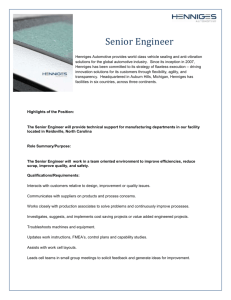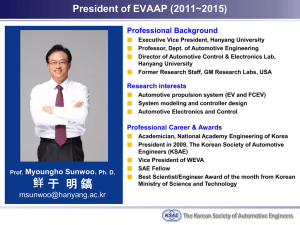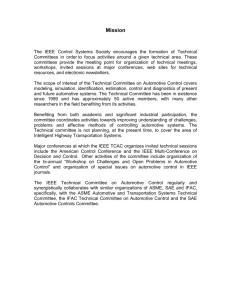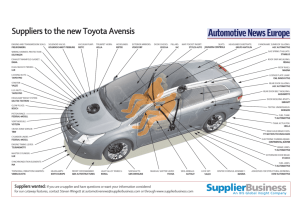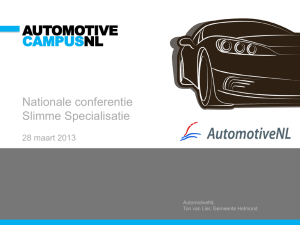Globalisation of Supply Chain Management for an Automotive
advertisement
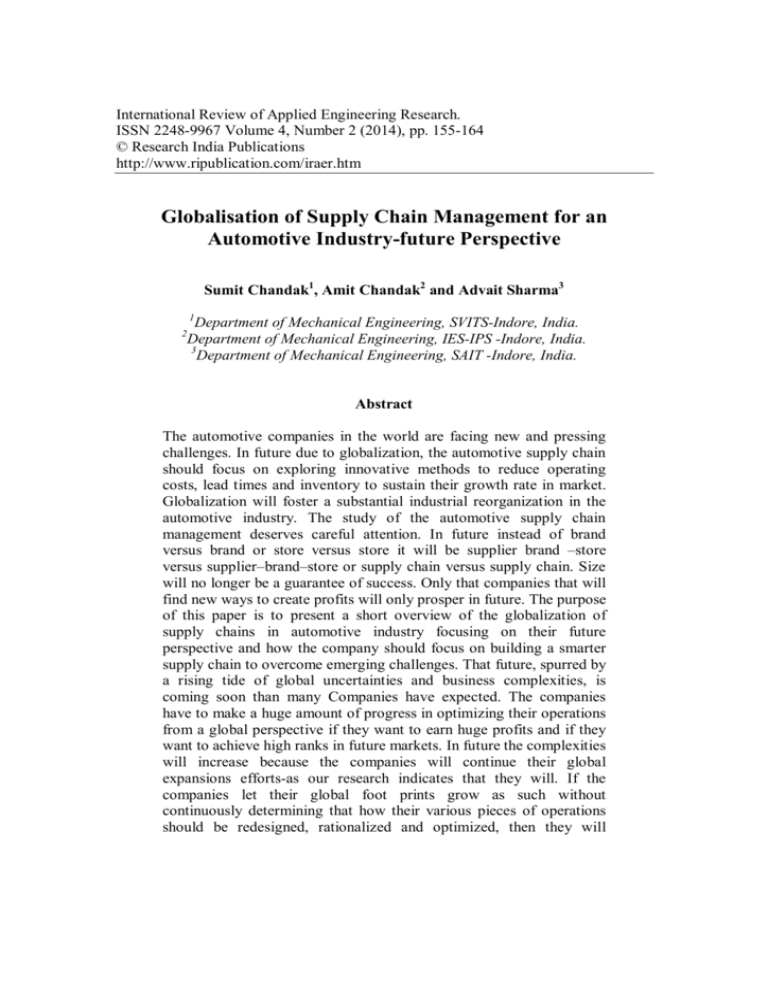
International Review of Applied Engineering Research. ISSN 2248-9967 Volume 4, Number 2 (2014), pp. 155-164 © Research India Publications http://www.ripublication.com/iraer.htm Globalisation of Supply Chain Management for an Automotive Industry-future Perspective Sumit Chandak1, Amit Chandak2 and Advait Sharma3 1 2 Department of Mechanical Engineering, SVITS-Indore, India. Department of Mechanical Engineering, IES-IPS -Indore, India. 3 Department of Mechanical Engineering, SAIT -Indore, India. Abstract The automotive companies in the world are facing new and pressing challenges. In future due to globalization, the automotive supply chain should focus on exploring innovative methods to reduce operating costs, lead times and inventory to sustain their growth rate in market. Globalization will foster a substantial industrial reorganization in the automotive industry. The study of the automotive supply chain management deserves careful attention. In future instead of brand versus brand or store versus store it will be supplier brand –store versus supplier–brand–store or supply chain versus supply chain. Size will no longer be a guarantee of success. Only that companies that will find new ways to create profits will only prosper in future. The purpose of this paper is to present a short overview of the globalization of supply chains in automotive industry focusing on their future perspective and how the company should focus on building a smarter supply chain to overcome emerging challenges. That future, spurred by a rising tide of global uncertainties and business complexities, is coming soon than many Companies have expected. The companies have to make a huge amount of progress in optimizing their operations from a global perspective if they want to earn huge profits and if they want to achieve high ranks in future markets. In future the complexities will increase because the companies will continue their global expansions efforts-as our research indicates that they will. If the companies let their global foot prints grow as such without continuously determining that how their various pieces of operations should be redesigned, rationalized and optimized, then they will 156 Sumit Chandak et al necessary build huge redundant costs while also losing opportunities for higher growth and profits. Keywords: Supply Chain Management, Globalization, Smarter Supply Chain. 1. Introduction There have been many changes and advancements in the business conditions of the 21st century due to which the companies are facing new challenging issues ranging from globalization, economic uncertainties up to new technological changes and increase in demands of the customer. In the automotive industry as manufactures design and build vehicles globally the supply chain becomes more and more complex with many challenges that often stand in the way of higher share holders value and profitably such as very long order to lead delivery times, unreliable production schedules, excess inventory across supply chains, lack of visibility of suppliers and lengthy demand planning cycles. But above all these factors that hinders the effective supply chains in generating huge profits is that of globalization. Globalization is the primary challenge that ranks higher. Due to the effect of globalization, in future there will be increased pressure on the automotive executives to make right decisions about their supply chains for better performance. The future environment of the market will be highly challenging and competitive and therefore an effective and smarter supply chain strategy will be an effective tool for improving the organization competitiveness. In future, an effective and efficient supply chain will be a must for automotive manufacturers and their component manufacturers so as to earn profits and good market position globally. In this dynamic environment a superior supply chain is a critical element in helping automakers in differentiating themselves from competition. In fact many of the automotive industry are reinforcing the needs to innovate and redefine supply chains strategies, layout and operations. If the system could be managed efficiently supply chain could be a major force in building sustainable competitive edge for the company in the coming highly competitive market. Globalization can be defined as a phenomenon, a process, a state or a concept. It has evolved partially because of the trend for increasing international trade across national boundaries and the conduct of business activities in more than one country and because of the changes in the various aspects of the international business environments. Put in simple words, it is a process that refers to the growth of interdependencies between national markets and the industries on a world wide scale. This growing interdependency between the national economies thus resulted in a trend towards global markets, global production and global changes in the competition. The changes in the political attitudes and economic policies have allowed the companies to take advantages of the technological advances. [1]There has been much convergence of global economic thinking .Also social trends have also changed as consumers apparently became less concerned with national identity of product. Theodore Levitt (1983) was one of the first academics to write Globalisation of Supply Chain Management for an Automotive Industry-future 157 about globalization. In 1983 he said that technology is the driving force behind the globalization of markets and, thus, a ‘converging commonality’ in countries around the globe. He recommended that: Communications; Transport; Travel; Products; and Processes; Were all leading to an ‘irrevocable homogenization’ of demand? Levitt’s key assumption or Hypothesis was that local tastes and preferences will vanish if the product is cheap enough. The implication of this is that: Identical products will be sold in all markets; and Industries will be dominated by global corporations benefiting from huge economies of scale. An alternative view is put forward by writers such as Douglas and Wind (1987) and Ohmae (1989) who suggest that some products are ‘global’, others are not. They point out that there are many barriers to standardization and that companies cannot ignore local consumer needs. Indeed, companies can gain considerable benefits by making minor changes to suit different national markets. That is not to say companies should ignore the attractions of standardization. If companies can standardize, even to a small extent, then they will be able to avoid duplication of effort in, for example, research and development and provide the same products in markets where this is acceptable. The emphasis is, perhaps, best summed up by Kenichi Ohmae’s famous phrase ‘Think globally, act locally’. In essence, this can be seen to mean that companies should regard the globe as one market, but should make changes to their products and services when necessary, to better serve each local market. George Yip’s (2003) model provides further insight into the forces driving globalization. It helps us to understand the pressure that industries are under to globalize. Yip also says that an understanding of the global forces assists a company to identify the critical success factors in a global industry and market [1]. Market drivers: Similar customer needs and tastes; The existence of global customers; TRANSFERABLE marketing between different countries. Competitive drivers: Competitors’ global strategies; Country interdependence. 158 Sumit Chandak et al Cost drivers Scale economies and scope including product development costs – experience curve; Favorable logistics; Country-specific differences Government drivers are numerous and include Trade policies; tariff barriers; subsidies to local companies; ownership restrictions; Local content requirements; controls over technology transfer; intellectual property Regimes; currency and capital flows; Marketing regulations; host government concerns; technical standards 2. Impact of Globalisation on Supply Chains-emerging Challenges and Remedies to Them The automotive industry is one of the most global industries amongst all the industries in the world. The automotive industries are always at the forefront of establishing the global infrastructure. They will be faced by many challenges at global level. In order to earn huge profits and to successfully build and expand their existing infrastructure at the global level they will have to make an efficient and smart supply chain keeping future market in mind. In the globalised markets other industries will also try to earn a good status and profits at global level and so automotive industries will get high competitions from other industries also. Also as the companies will try to join the global markets and for that they will globalize their existing infrastructure. They will be faced by operational issues in the form of quality and delivery reliability. These two operational issues will be the top challenges for entire automotive companies. With the existing supply chains the companies are not getting those benefits and profits which they have anticipated from their global supply chains. In future the globalization will increase. According to the market research data it was estimated that only one third of the automotive companies supply chains have improved their overall performances as result of globalization and their profits were also improved accordingly. In contrast near about 70% of the top supply chains have reported that because of globalization the overall performance of the companies has been improved. In addition to it now they are trying to make important factors such as delivery reliability and quality issues under their control and they expect that they can completely get hold on these issues in years to come. In future the top concern for the automotive companies will be more advanced business issues like regulatory and legal challenges of the international supply networks and the cultural and organizational level obstacles which will result because of increasingly virtual relationships. To achieve a global status the focus of automotive supply chain should be on integrating their global chains. This will include integrating the product life cycle management and enterprise resource planning for its partners. Also apart from it they should use tools such as collaboration, sharing of Globalisation of Supply Chain Management for an Automotive Industry-future 159 knowledge and social networking because they will help them to remove distance gaps and will make people networks across the extended value chains .To support integration a smarter supply chain should establish common terminology and process. Fig: 1: An Overview Of the supply chain management of an automotive industry. The supply chain should be such that they should not run each facility separately instead they should manage the resources globally by matching the demands with manufacturing capacity and sourcing around the world. These supply chains should use intelligent business analytics to track and synchronies demands and supply trends, evaluates complex scenario and acts based on the most likely outcomes. This insight along with the supply chain flexibility allows the smarter supply chains to adjust sourcing and production planning to optimize the operations globally. The top 5 primary challenges across automotive industries are 1. Visibility 2. Risk 3. Cost containment 4. Customer demands 5. Globalization The Most crucial factor that is of huge concern to the automotive industries is that of globalization. Due to globalization these effects are even more challenging. The automotive companies will need a much efficient smarter supply chain that must contain characteristic such as instrumental, interconnecting, and intelligent. Instrumental-they should make use of sensors and smart devise to gain greater visibility across networks, mitigate risks, reduce costs and manage rising complexities. Interconnecting-integrating real time Intelligent-they should more on advance analytics .simulation and modeling tools to evaluate increasingly complex and dynamic risk and constraints and to act on better insights. 160 Sumit Chandak et al A much smarter supply chain approach will allow an automotive supply chains to make progress against all of the above mentioned challenges. Simultaneously the global automotive company will be subjected to a range of factors that will create complexities and influence the economic options available to automobile manufacturers. Many of these factors are market induced and therefore they cannot be influence directly by the automobile manufacturers. Globalization and market convergence-the national markets are increasingly globalized due to the effects of liberalization. This will give a chance to OEM’S to expand their new markets but it also increases the threats of new entrants or increased competition in traditional markets. The reverse of globalization is regionalization which means that the consumer preferences should be considered by companies. The concept of the standardized “world car” which was given by FORD, will not be successful in future. Digitalization will also create problem for OEM’S because due to digitalization market convergence will be there. And also the increase in diversification of the consumer aggregate patterns of behavior will also be there. In future the consumers will no longer take standardized products but they will take those products that will satisfy their individual requirements. For the industries customers are the main source of profits. Hence the companies should downsize the target groups so that the customers are attracted by the products which are offered to them. But there will be very high global competition and there will be a strong focus on the price not on brand so consumers will not appreciate companies for their products. Due to these complexities the automotive companies require new requirements in different fields: 1. They will have to diversify and modify their product portfolio. The manufacturers will have to reduce their product life cycles so that they can efficiently react to individual and fast growing consumer demands with their innovative products. 2. Digitalization of automobiles: In recent years the digital technology in cars average approximately 30%of the total value of a car. This situation is furcated to increase to 70%of the total value in future. The integration of new hardware and software features in the automobiles shows the acceleration of the new functions linked with new complexities. This will results in car development departments being outsourced, failure of products, guarantees and warranty issues and impact on consumer satisfaction. There will be increase pressure for innovations and flexibility in developments. The developments departments will not just be overburdened by the complexities of digital technologies but also due to the shortening of products lifecycles. Also OEM’S works Globalisation of Supply Chain Management for an Automotive Industry-future 161 parallel on large numbers of different projects of different companies to produce more and more number of high end models for special target groups. This will definitely require development techniques such as virtual reality. Also for this flexible assembly lines will be required so that OEM’S can react to individualized consumer demands. But only flexibility cannot be assured using new technology. Also the companies new production concept have to be developed so that complexities that will arise in automobiles production can be systematically managed which will require the activities and responsibilities being outsourced to a variety of partners. Hence new ways of managing the cooperative partners will be needed. Many new challenges will be faced by the automotive industry in future. Some of the key challenges that will affect the supply chains remarkably are as follows: 1. The fluctuations in the market demand and rising customer demands will be key challenge in the automotive sector. 2. Lengthy demand cycles and the lack of visibility to suppliers, materials and production constraints will cause scheduling delays and short term changes in production. 3. The company will be faced with huge global crisis. This will lead to increased pressure on the competitive performance of automotive industry. 4. The recent emphasis on the climate changes is increasing the pressure on the automotive executives to make right decisions in many areas-including R&D and manufacturing. 5. General macroeconomics and financial circumstances will not be favorable either. 6. As the global demand will rise hence the cost of energy and raw materials will also increase continuously. 7. Very strong fluctuations will be there in exchange and interests rates and they are difficult and costly against which to hedge. 8. High cost and low cost margins are constant challenges faced in the automotive industries worldwide. At that time only some established companies will only get satisfactorily profits. 4.1. A Smarter Supply Chain Approach to Mitigate These Emerging Challenges in the Coming Global Market In Future The companies should manage materials and capacities across global networks –the automotive companies will need a global view of demand in a common format so that they can make effective decisions on capacity management, sourcing and profitably allocating the vehicles and their operation content. 1. The industries should optimize prices, channel inventories and order to delivery process- in the automotive industries customer always wanted more contents in less money and the regulations expects more safety, lower emissions and higher fuel economy. 162 Sumit Chandak et al 2. The companies should be able to synchronies options content with the parts-the critical challenge in the automotive supply chain is that of the synchronization of sales and marketing requirements and forecasts with parts flowing in from suppliers. This challenge should be tackled by the proper management of demands on the front end of supply chain to be seamlessly linked to materials requirements on the back end of supply chain. 3. 4.The supply chain should be linked to new products to manage the total enterprise costs- this should be done so as to manage the total enterprise costs across the product that is on the R&D, operations etc. 4. The out sourcing should be done from the low price, high quality suppliers-the automotive industry will benefit from this new possibility in out sourcing from low price high quality suppliers. 5. The smarter supply chain should be such that there should be a series of activities or solutions so that the wastes are eliminated, non value added operations should be improved efficiently, it should easily adapt to the changing requirements of customers with time and it should make the organizations and facilities to become more flexible and responsible to the needs of the customer. 6. The concept of “lean “and “agile” supply chain should be combined because it will make a system in which the advantages of leanness and agility will be combined by positioning the decoupling points in order to best suit , the need for responding to a more volatile demand downstream but still providing level schedule upstream from decoupling. 7. The companies should extend their supply chains and make sustainable use of raw materials. The automobile industries use more advanced technologies, hence the material content of the vehicle becomes more varied. Therefore the companies should make buyer supplier relationships more strong that will enhance performance throughout the supply chain. Exploitation of supply chain by power partners can result in failure and under performance, thus affecting power holder. In future due to increasing globalization the market will be a highly competitive one, therefore an effective and efficient global supply chain will be a must for an automotive company if they want to keep themselves in the race with their counterparts. The complete landscape of the industry will be exposed to a set of new critical challenges and trends that will be leading, if not accelerating, the need to fine tune supply chains strategies and operations even further. 3. Conclusions In future the landscape of automotive industry will be exposed to a set of critical challenges. There will be more complexities due to increased globalization due to which there will be many new challenges will emerge in the automotive industries and hence they will have to overcome these complexities and find new ways to create profits if they want to prosper. In coming years the environment will be highly competitive, hence the need of an effective and efficient global supply chain will Globalisation of Supply Chain Management for an Automotive Industry-future 163 become a necessity for automotive industries. This can be done by optimizing their existing supply chains and infrastructure and building an efficient and more effective supply chains and strategies which will earn them good market position and status even in a highly globalised markets. These companies will have to respond to new challenges and changes with a strong focus, responsiveness, variability and resilience. Automotive industries can do this by preparing themselves in the strategic areas which are discussed in this paper and they can also prepare themselves for new challenges yet to come. The automotive companies should prepare themselves before the market takes a huge turn. We have focused on some of the major challenges that will surround the automotive companies due to globalization. We have attempted to identify issues and areas that may be important for industries in future and predicted few outcomes for them. Rather than commenting on the unpredictable nature of many of the changes that have occurred and will continue to occur. Currently, automotive companies across the globe are embroiled in a worldwide industry transition. Approximately everything about their businesses is transforming – their products and services, where and how they’re sold, even also their business models of industry. Automotive supply chains are at the centre of this chain. For automotive companies, emerging from this complex period of transformation as healthy, vibrant businesses depends largely on how they adapt an efficient and smarter supply chains .Greater speed and efficiency will help, but this will not be sufficient enough. Automotive supply chains will need a fact-based intelligence to predict what kind of future scenarios are most likely to occur – and the flexibilities to get reposition them before they do. In future smart wins now more than ever. References [1] [2] [3] [4] [5] [6] [7] Globalizations, challenges and changes Ian Brooks, Jamie Weatherston and Graham Wilkinson Evaluating Four Supply Chains In The Automotive Industry By a SCM Analytical Schema- Luiz Felipe SCAVARDA, Sílvio HAMACHER, Sílvio R. I. PIRES Company- Actors on the Look Out for New Compromises Developing GERPISA’s New Analytical Schema 11-13 Juin 2003 (Ministère de la Recherche, Paris, France) Integrating business processes for global alignment and supply chain management- Rodney McAdam and Daniel McCormack University of Ulster, Belfast, Northern Ireland, and UK Innovation in the Automotive Industry Roberto Cullino, Cristina Fabrizi, Andrea Linarello and Andrea Orame IBM Business Consulting Services Challenges for the automotive industry in an on demand environment seven areas of strategic action THE SMARTER SUPPLY CHAIN OF THE FUTURE GLOBAL CHIEF SUPPLY CHAIN OFFICER STUDY-IBM. Automotive- Indian Automotive Supply Chain- A Discussion Paper by KPMG; 2006. 164 Sumit Chandak et al
